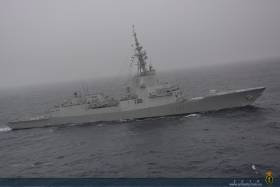Displaying items by tag: NATO exercise off Scotland
Spanish Navy Frigate Among NATO Flotilla to Visit Dublin Following Major Exercise off Scotland
#SpainScotland - French Navy ships are currently visiting Dublin Port with more to come among them the Spanish that also participated in Joint Warrior 172, Europe's largest military exercise for some time that had taken place off Scotland, writes Jehan Ashmore.
The UK led multi-national exercise involving some 30 warships from NATO, numerous aircraft, marines and troops had been testing anti-terrorism tactics, piracy, humanitarian missions and other duties. Asides the French and Spanish the multinational flotilla included the Royal Canadian Navy. All these navies are scheduled each to send a frigate to Dublin before next mid-week.
The French will again be represented by FGS Provence, the fourth caller since yesterday. The other frigates are the Canadian Navy's HMCS Montréal and from Spain Álvaro de Bazán. The country on 1st October drew worldwide attention given the independence referendum held in Catalonia. This was in marked contrast as only yesterday, 12th October was the National Day of Spain.
The “Álvaro de Bazán” class frigate belongs to the 31st Escort Squadron based in Ferrol, Corunna in north-west Spain. The frigate was launched locally in Ferrol on October 27th 2000 at the NAVANTIA Shipyards. The frigates motto and coat of arms is “Rey Servido y Patria Honrada” which translates to Served king and Honoured Homeland.
Another referendum but this time on Scottish independence took place in 2014. It was somewhat ironic that the 147m Spanish frigate had called to Glasgow only last week.
The leadship of the Álvaro de Bazán frigate class is of a modern design that according to the Spanish Navy has a remarkable military capability. The frigate is equipped with an AEGIS Combat System that makes the class a most valuable asset at the service of the Nation’s foreign policy, not only in conventional operations, but also in peace-keeping and humanitarian aid missions, enforcement of UN resolutions, etc.
This year, Joint Warrior 172 overlapped with Formidable Shield 17 - a U.S. led joint NATO live fire Integrated Air Missile Defence (IAMD) exercise. Both exercises had provided a complex environment in which allied units trained together in tactics and skills for use in a combined joint task force.
In addition our very own L.E. James Joyce, the second of three OPV90 /Playwright sisters completed, will dock in Dublin on Monday before this contingent of the NATO flotilla arrive. Firstly on Tuesday, HMCS Montréal is scheduled while on Wednesday it will be the turn of both FGS Provence and Álvaro de Bazán.
In the reporting of visiting naval vessels, the schedules can be fluid, so much so that due to operational reasons such ship visits can be swapped around, delayed or even be cancelled.





























































